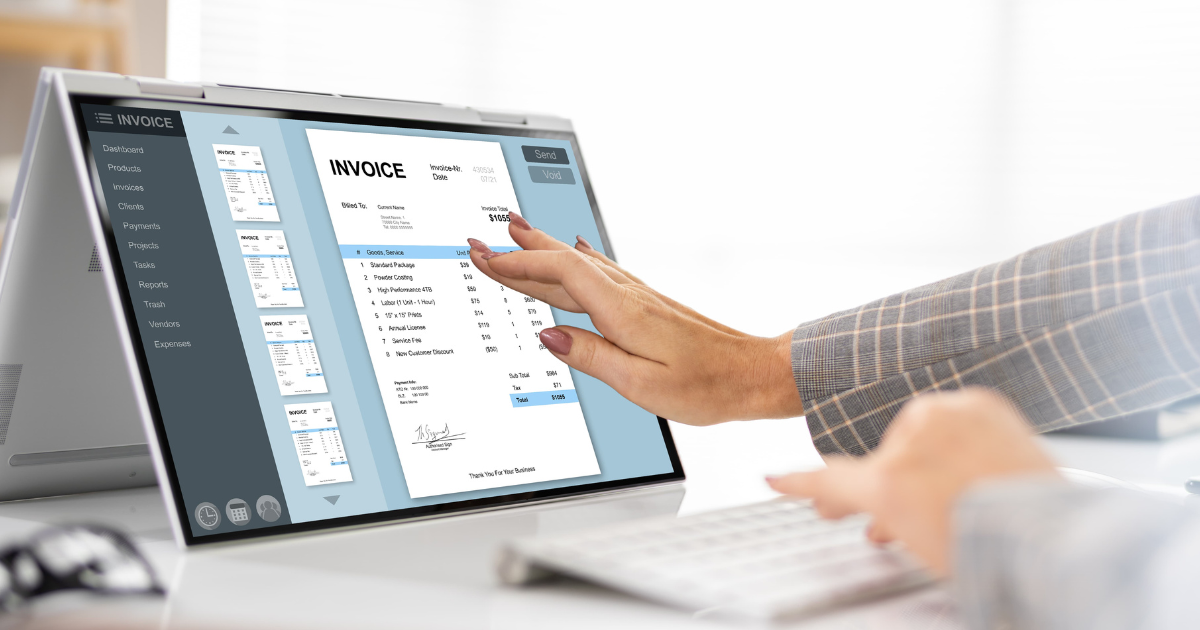Strategies for Effective Invoicing and Timely Payments to Improve Cash Flow
For small businesses, selling a product or delivering a service is just the beginning. Until you've been paid, the transaction isn't truly complete. Effective cash flow is the backbone of small business success. Effective invoicing and timely payments are the arteries of your business's financial health, crucial for maintaining a steady cash flow. Read on to discover proven strategies for getting those invoices right and ensuring payments land in your bank account when you expect them.

For small businesses, selling a product or delivering a service is just the beginning. Until you've been paid, the transaction isn't truly complete. Effective cash flow is the backbone of small business success. Effective invoicing and timely payments are the arteries of your business's financial health, crucial for maintaining a steady cash flow. Read on to discover proven strategies for getting those invoices right and ensuring payments land in your bank account when you expect them.
The Role of Invoicing in Cash Flow Management
Invoicing isn't just paperwork; it's a fundamental part of your cash flow strategy. Let's dive into the dynamic role invoicing plays in cash flow management.
Beyond Just Billing: The Strategic Value of Invoicing
Invoicing is your claim ticket to revenue, and it also sets the tone for your business relationships. A well-crafted, accurate invoice reflects professionalism and credibility, making clients more likely to pay on time. An invoice that's well-designed and easy to read can also build trust between you and your client, effectively serving as a silent ambassador for your brand.
Moreover, a good invoicing system can offer insights into your business operations, from sales trends to customer payment habits. These insights can be invaluable for cash flow forecasting and planning. For example, by analyzing your invoices, you might identify which clients consistently pay late, enabling you to take proactive measures.
The Snowball Effect of Inefficient Invoicing
Lackluster invoicing isn't just a minor annoyance; it's a seed for potential cash flow chaos. Misspellings, incorrect amounts, or unclear payment terms can lead to delays or disputes, which can eat up valuable administrative time.
More significantly, a backlog of unpaid invoices can rapidly escalate into a financial mix-up, making it difficult to meet operational costs or invest in growth opportunities. These accumulated unpaid invoices can constrain your working capital, hindering your ability to take on new projects or make timely payments to your own suppliers.
Crafting the Perfect Invoice
An effective invoice is your best bet for timely payments. So, what makes an invoice 'perfect'?
Clarity is Key: Itemizing Services or Products
An invoice isn't the place for ambiguity. Clearly itemizing your services or products not only validates the charges but also helps the client understand what they're paying for. The more detailed you can be, the better. Clients appreciate knowing exactly what each charge corresponds to, which can prevent disputes down the line.
This level of detail minimizes questions and accelerates the approval process, shortening the payment cycle and improving your cash flow. It also allows your clients to better understand the value you're providing, which can be beneficial for long-term business relationships. By eliminating guesswork, you make the process easier for your clients and expedite your own cash inflow.
Essential Components of an Invoice
An invoice should include specific elements:
- Business name
- Client details
- Invoice number
- Description of goods/services
- Due date
- Payment terms
business name, client details, invoice number, description of goods/services, due date, and payment terms. Each of these elements serves a unique purpose, such as making it easier for your client's accounts payable department to process the invoice or providing legal protection in case of disputes.
Missing any of these components can result in delays or create a window for disputes, neither of which is good for your cash flow. For instance, forgetting to include the due date may make it unclear when the payment is expected, while not specifying payment terms can lead to misunderstandings about how the payment should be made.
Payment Terms and Deadlines
Explicit payment terms are a non-negotiable part of an effective invoice. Clearly indicate whether you expect payment within 15, 30, or 60 days. This helps set client expectations and creates a reference point for late fees, if applicable.
By setting and communicating these deadlines, you create a sense of urgency around payment, making it more likely you'll be paid promptly. Consistently enforcing payment terms is vital. It not only establishes professionalism but also ensures a steady revenue stream. Furthermore, you'll be able to forecast your cash flow more accurately by knowing when to expect incoming payments. This enables you to make smarter decisions around expenditures, investments, and other financial commitments.
Facilitating Timely Payments
Invoicing is half the battle; getting paid on time is the other half. So, how can you encourage your clients to pay promptly?
Communication Channels for Payment Reminders
In a perfect world, all clients would pay on time, every time. Unfortunately, that's often not the case. Email reminders can be an efficient and non-intrusive way to remind clients that payment is due, especially if you set up an automated system. Phone calls can be reserved for clients who habitually pay late or for larger invoices that carry more weight on your balance sheet. When making phone calls for late payments, approach the situation with empathy and professionalism.
In addition to emails and calls, automated invoicing software with reminder functionality can also be effective. This software often allows you to schedule reminders at intervals—perhaps one week before the due date, two days before, and then daily after the due date has passed. The automation ensures consistent follow-up and frees up your time to focus on other tasks, helping to streamline the payment collection process.
Rewarding Prompt Payments
Incentivizing payments can be an effective strategy. Early payment discounts, even if it's just 1% or 2%, can serve as a financial incentive for your clients. This may not seem like much, but to a company with a tight budget, every percentage point counts and can translate to considerable savings over time. While incentives are a great way to encourage timely payments, small businesses should ensure that these discounts don't drastically impact their profit margins.
This doesn't just speed up individual payments; it fosters a culture of prompt payment within your client base, helping to stabilize your cash flow over the long term. This culture of timeliness can become a powerful asset for your business, as it can lead to more predictable cash flow and therefore, better financial planning and strategy.
Handling Late Payments Tactfully
Even with perfect invoicing and polite reminders, some payments will inevitably be late. Diplomacy is key when addressing late payments in order to preserve long-term business relationships. A graduated response strategy, starting with gentle email reminders and escalating to phone calls or legal actions, can be effective. It's important to document all communications related to late payments. This not only helps in tracking but can be beneficial in potential disputes.
It's also essential to keep the lines of communication open. Understanding the reason behind the delay can offer insights into whether this is a one-time issue or likely to be a recurring problem. This will help you decide whether it's worth altering your payment terms or even continuing the business relationship with the client in question.
Leveraging Technology for Invoicing and Payments
The digital age has brought many tools that can streamline invoicing and payment processes. Let's delve into how technology can be your ally.
Automating Invoicing Processes
Invoicing software can be a game-changer for small businesses. Automating many manual tasks, like tracking unpaid invoices or sending payment reminders, not only saves time but also significantly reduces the risk of human error. Errors can delay payments and erode client trust, so eliminating them can only improve your cash flow and business reputation.
Moreover, some advanced software solutions even integrate with your accounting system, keeping all financial transactions and statuses up to date. This seamless integration simplifies your workflow, reduces redundant data entry, and allows you to generate insightful reports that can help in making informed financial decisions.
Digital Payment Options
The easier you make it for clients to pay, the faster you'll get your money. Offering multiple payment options, such as credit cards, digital wallets, or bank transfers, makes it more likely that clients will pay promptly. Nowadays, clients expect convenience, and businesses that can offer hassle-free payment methods have a competitive edge.
Many invoicing platforms now include various payment options, giving clients the flexibility to pay in the way most convenient for them. And the quicker clients can process payments, the faster you can close out invoices and recognize revenue, helping to maintain a healthy cash flow for your business.
The Legal Side of Invoicing and Payments
Financial transactions are also legal transactions. Let's take a look at some legal considerations in invoicing and payment collection.
Contracts and Agreements
Before any work starts, having a well-drafted contract in place is essential. This contract should outline not just the scope of the work but also the payment terms, due dates, and any late fees or penalties for delayed payment. It serves as both a guide for how and when you should invoice the client and as a legally binding document that can be used in case disputes arise.
Additionally, the contract should explicitly mention the consequences of non-payment or incomplete payment. This ensures that both parties are aware of the stakes involved and provides you with a legal basis for action if needed. Legal clauses like these are not just standard practice but a critical safety net for any small business.
What to Do When Payments Don’t Come Through
The reality is, despite the best plans and contracts, some payments will fall through. When this happens, your first recourse should be to consult the contract. The contract will usually outline the steps you can take, such as applying late fees or even halting work until payment is received.
Before jumping to legal action, however, consider alternative dispute resolution methods like mediation or arbitration. These are often less confrontational, faster, and less costly than going to court. In many cases, a neutral third party can help facilitate a resolution that is satisfactory for both you and the client, thereby preserving the business relationship. Even if mediation is not specified in your initial contract, it can be agreed upon as a first step before more drastic measures are taken.
Elevate Your Invoicing Game
Effective invoicing and timely payments aren't just about keeping the lights on; they're about creating a financial structure that allows your business to grow. By implementing the strategies we discussed above and leveraging the right tools, you'll be well on your way to improving your cash flow, giving you more freedom to focus on what you do best: running your business.
Want to get your invoicing and payments on point? Cassie offers robust tools for tracking invoices and cash flow management designed to take your business to the next level. Don't just chase payments; plan for success with Cassie.
Mary Achurra
2024-01-28
Get the cheat sheet and checklist for free
The software tools evaluation checklist will help you choose the best solution for your business.
Latest articles
Get started for free today
Get 21 days free access to our platform and improve your business.





